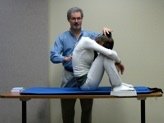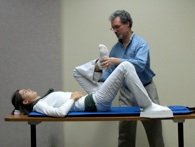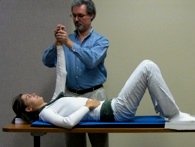![]() Minnesota Center for the
Minnesota Center for the
Alexander Technique (MinnCAT)
The Alexander Technique
What is it?
The Alexander Technique features an educational student/teacher relationship. The goal is to improve skill and poise in everyday living and the result is often a permanent solution to musculoskeletal pain and obstacles to learning and improving skilled activities.
Discomforts and obstacles to skilled performance are often "use-related", This pertains to "how" actions are initiated and carried out — often, unfortunately, with mis-directed muscular effort. As one stops unconscious, interfering habit patterns, a natural, easy approach will foster coordinative strength, improved kinesthetic sense, skill development, and productivity. The indirect result is reduction or elimination of musculoskeletal discomforts. Additionally, stress can be better controlled when we understand how our reaction to stress is that of "strain".




F.M. Alexander (1869-1955) developed a blend of what looks like a combination of education, physical therapy, psychology, counseling, and scientific inquiry. He founded what may be considered the original mind/body approach in the Western world.
You can Benefit !
Sometimes you work at a computer and find your shoulders becoming tight. Sometimes you play golf or tennis and know that bad habits prevent you from improving your game. Sometimes you practice music and find yourself becoming stiff, sore, tense, and your tone getting thinner.
Due to a phenomenon called “unreliable sensory awareness”, we become accustomed to the tension we carry with us. Unless we are in pain, we don't notice the tension and stiffness. Yet our inappropriate efforts have a powerful impact on every goal we set out to accomplish. Our internal feedback system, or kinesthetic sense, which would normally tell us when something is going wrong, becomes unreliable, and creates road-blocks to making changes in ourselves. The Alexander Technique helps the kinesthetic sense become a more accurate guide so that you can take on new activities, as well as old ones, with greater ease, freedom, and control.
Benefits can include greater ease in movement, more freedom of choice, improved coordination, a stronger back, and increased energy. You gain a newfound, immensely practical skill in learning to identify and stop destructive patterns of behavior that interfere with how you move, learn, and respond to your environment.
- Extra info for musicians here.
How is it Learned?
The Alexander Technique is taught in one-on-one sessions lasting about forty minutes, or, sometimes in small group classes. Dressed in comfortable clothing, you are guided through simple movements with verbal instructions and subtle touch. During the lesson, you learn to observe and change habits that interfere with optimum functioning. Becoming aware of and changing the habits that interfere with these simple activities builds a foundation for tackling more complex problems. The effect is a pleasurable lightness and ease.
Muscular habits can be resistant to change. Therefore, part of the lesson usually takes place lying on a table. The teacher can help a person change some of their habits without the interference that often happens during even the simplest acts.
The Significance of Skill & Poise
The Alexander Technique is a century-old method useful for absolutely everyone to improve functioning, skill, and poise. It is easy to see how performing artists, athletes, and craftspersons need to have a well-functioning and coordinated body. But we also need to “perform” all activities of life with skill and poise. In this way we prevent musculo-skeletal discomforts... AND, our performance at our favorite activities will also benefit. The Alexander Technique can improve all everyday activities — like sitting at a computer or washing a floor AND it will improve our favorite activities: like a craft, sport, fitness, or artistic endeavor
Jump to info on taking a lesson.
History of the Alexander Technique
Frederick Matthias Alexander (1869-1955) was a Shakespearean actor who had a chronic medical  problem which affected his performance. After ten years of careful self-observation, he discovered that he was creating a pattern of tension that was interfering with the natural relationship between his head, neck, and back. He learned to enable himself to inhibit this tension, and then re-establish a correct relationship. These discoveries — which have since been confirmed by scientists — enabled Alexander to resume his career, and became the foundation of the Alexander Technique.
problem which affected his performance. After ten years of careful self-observation, he discovered that he was creating a pattern of tension that was interfering with the natural relationship between his head, neck, and back. He learned to enable himself to inhibit this tension, and then re-establish a correct relationship. These discoveries — which have since been confirmed by scientists — enabled Alexander to resume his career, and became the foundation of the Alexander Technique.
At Respected Institutions
The Alexander Technique has been taught in a wide variety of academic and health settings including the American Conservatory Theatre, the Juilliard School, the London Academy of Music and Dramatic Art, Northwestern University, the University of Michigan, and several other prominent educational and healthcare institutions including, recently, the Mayo Clinic.





Video Lecture:
